NoMore

Transforming Smoking Cessation Through Behavioral Change
A wristband and app designed to interrupt smoking patterns and inspire progress through personalized insights and motivation
Impact
Increased user satisfaction by 79% during testing and enhanced purchase confidence for parents.
Team
Aravindh – UX lead
2 UX Designer
What I Did
UX/ UI Design
User research
Prototyping
Key Features
See What User Enjoyed
Meaningful Interruption
Real-time haptic feedback disrupts smoking habits by reducing inhalation duration.

Expressive Feedback
Visual and haptic cues on the band signal progress or warnings.

Healthy Motivation
Weekly challenges motivate users to stay engaged in their journey.

Personalized Progress
The app tracks and visualizes the user’s progress across multiple metrics

The Challenge
Empowering Smokers to Quit Through Behavioral Change
How might we create a solution that goes beyond reminders to actively support smokers in their cessation journey?
Why
Why This Challenge?
Prevalence of Smoking
14% of adults smoke, causing 480,000 deaths annually in the U.S.
Quitting is Hard
70% want to quit, but only 3–5% succeed without help.
Smoking Impacts Everyone
Affects smokers and those around them through secondhand smoke.
Key Research Activities
Semi-Structured Interviews
In-Store Observation
Literature Review

deriving high-level insights
Affinity Mapping
Grouped findings to identify themes in triggers, behaviors, and motivations.
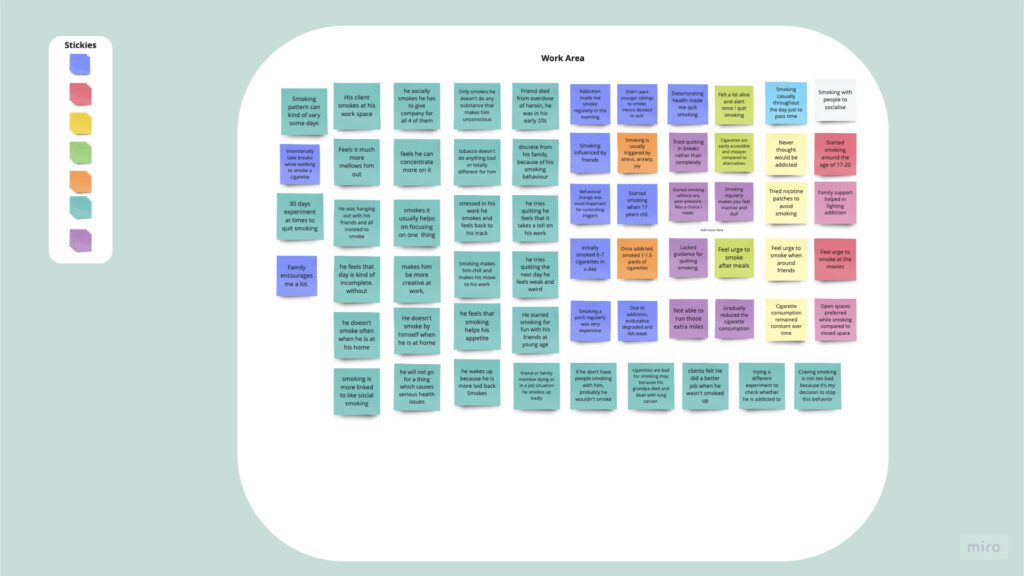


Empathy Mapping
Visualized smoker experiences to understand their needs and emotional state.

Why Initial Ideation Methods
Didn’t Work 56 raw ideas
But many were abstract and disconnected from real-world user needs.


Why the Creative Matrix Worked
Forced cross-pollination between user needs and feasible technology.
Focused on delivering realistic, meaningful solutions rather than abstract concepts.
Ensured ideas stayed grounded in the user’s journey and behavioral challenges.

Card Sorting
We applied several affinity mapping to synthesize our ideation data to lead to a down-selection process. From the top 60, we have voted the top three ideas that fall under these design principles, Convenient, Behavioural, and Motivational.

The parent or child scans the QR code on a toy using a mobile device or in-store tablet. showing a 3D model of the toy.
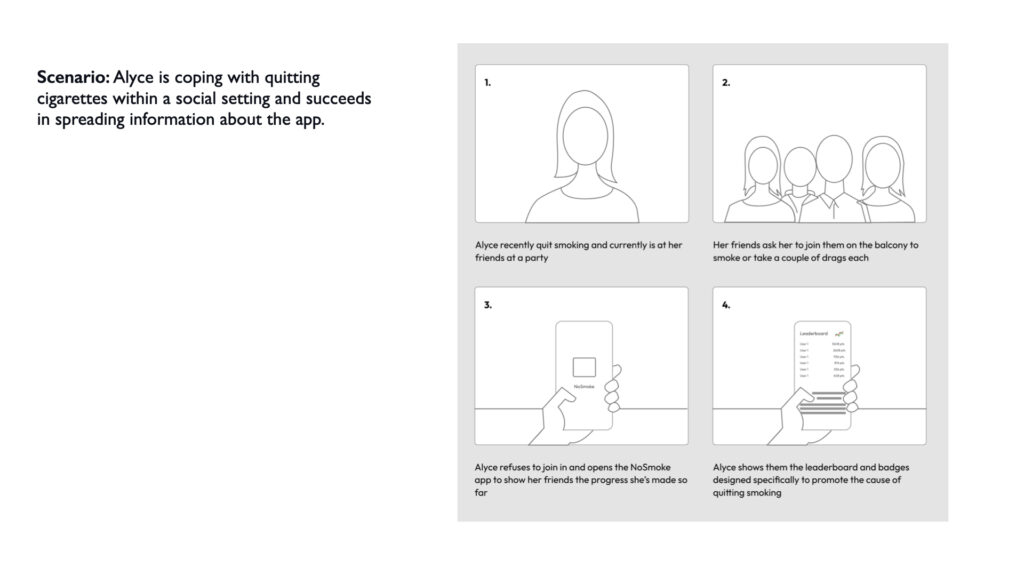
The AR screen displays key details like toy specifications, features, dimensions, and price.
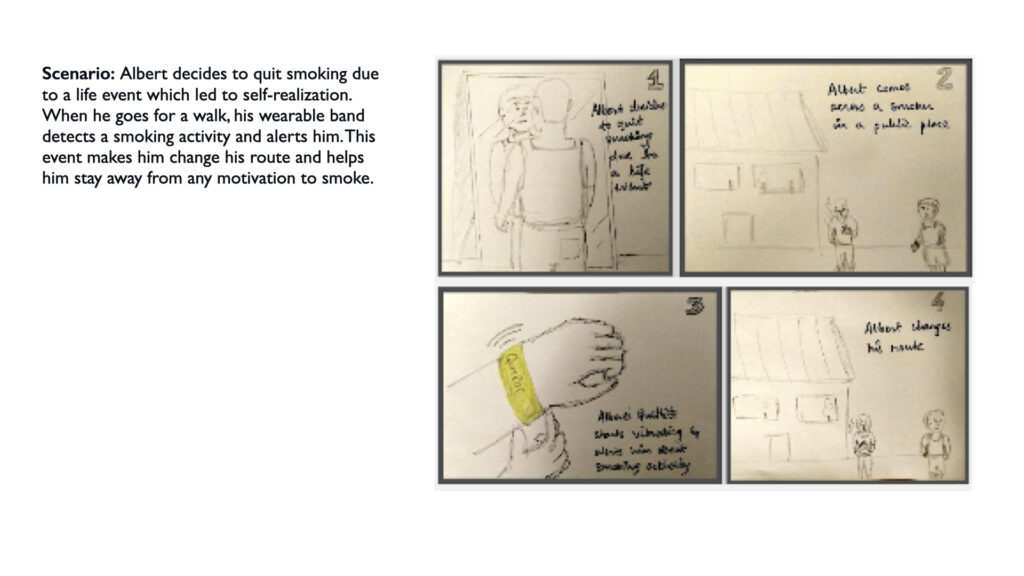
Tailor the experience to the user’s preference: functional for parents, fun for kids. Game mode VS Normal

The parent or child scans the QR code on a toy using a mobile device or in-store tablet. showing a 3D model of the toy.
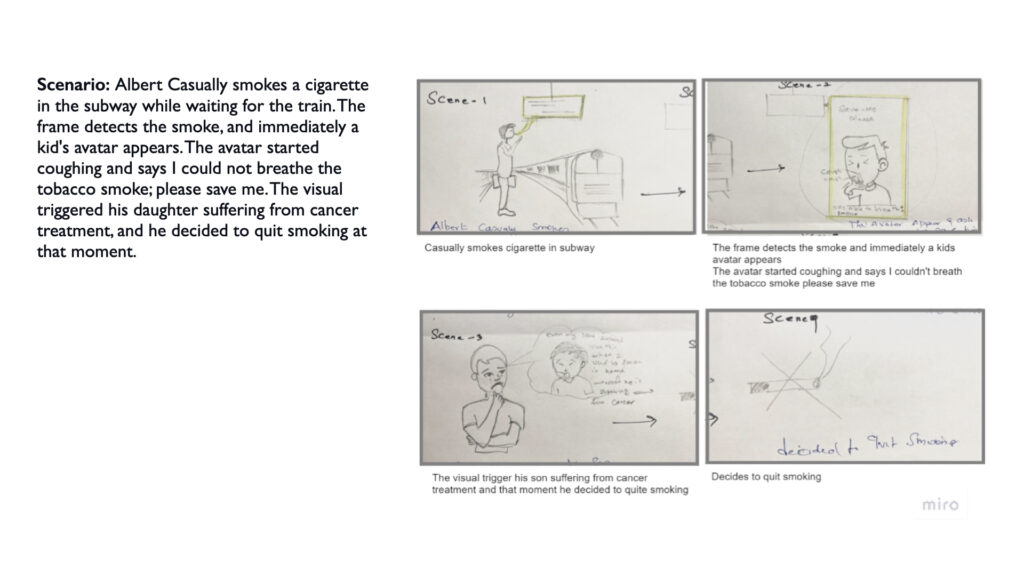
The AR screen displays key details like toy specifications, features, dimensions, and price.

Tailor the experience to the user’s preference: functional for parents, fun for kids. Game mode VS Normal
Designing for Behavior Change
User Flows
Daily Progress Tracking: Simple metrics for quick insights.
Feedback Mechanisms: Color-coded and haptic cues to signal progress or warnings.
Community Engagement: Challenges and forums to sustain motivation.

Scan QR Code: Users scan a toy’s QR code to access its AR experience.
Select Mode: Choose between Normal Mode for parents or Game Mode for kids.
Parents explore toy specs in Normal Mode.
Kids engage with gamified demos in Game Mode.
Wireframes
Band Feedback Interface: Visual and haptic notifications for real-time interventions.
App Dashboard: Progress tracking, weekly insights, and motivational challenges.

Validating The Solution
Testing the band and app to refine real-time feedback, progress tracking, and motivation systems.

Testing
Key Findings
Band Feedback: No visual progress updates on the band
Haptic Feedback: Repetitive vibrations caused confusion
App Data Visualization: Minimalist metrics felt disconnected
Iterations
Based on Feedback:
Band Feedback: Added progress bar on the band
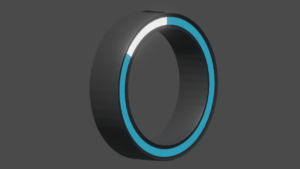
Haptic Feedback: Introduced distinct patterns for clarity

App Data Visualization: Enhanced app visuals to connect progress

Key Insights
See What Our Happy Customers need
Behavioral Loops Reinforce Addiction
Smoking is often triggered by stress, social settings, or routines.
User Quote: “I light up whenever I’m stressed—it’s like second nature.”
Smokers Struggle with Relapse
Many feel they’ve quit after short-term success, only to relapse due to ingrained habits.
Stat: 70% of smokers want to quit, but only 3–5% succeed without help.
Support and Motivation are Essential
Smokers need visible progress and encouragement to stay on track.
User Quote: “If I could see how much better I’m doing, I’d feel more motivated to keep going.
Key Insights
Final Screens
Reflections
Minimalism is Not Minimal Information
Minimalism isn’t just about clean design—it’s about delivering relevant, actionable insights at the right time. A visually appealing product may attract users initially, but true engagement comes from usability and meaningful connections.
Smart Technology Drives Connection
Using the right technology ensures the product feels accessible and seamless. Solutions that are too futuristic or outdated can overwhelm users, increasing cognitive load and reducing engagement. The right tech enhances the experience, making it intuitive and impactful.















